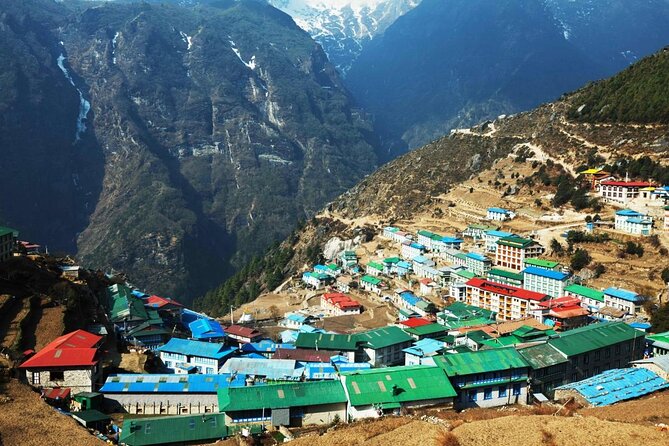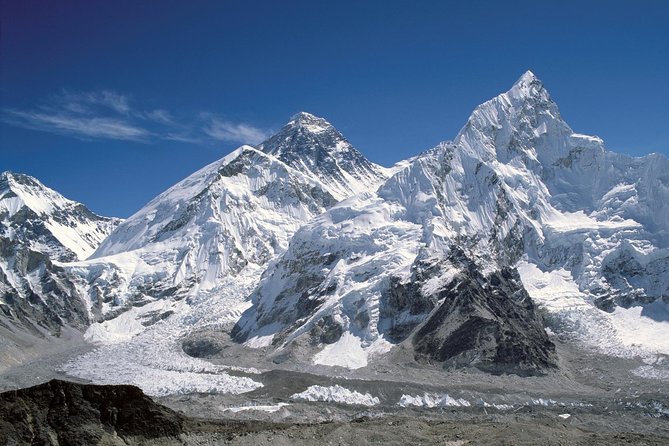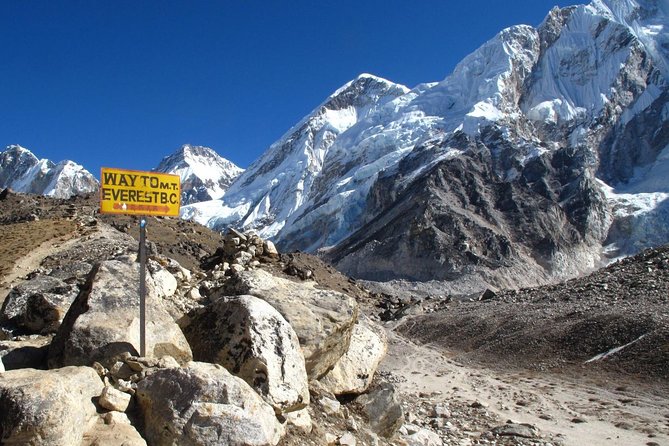Everest Base Camp Lifetime Adventure Trek
Have you ever wondered what it would be like to stand at the base of the world’s highest peak?
The Everest Base Camp Lifetime Adventure Trek offers a unique opportunity to explore the rugged beauty of the Himalayas while pushing your limits both physically and mentally.
From navigating challenging terrain to enjoying the rich Sherpa culture, this trek is a test of endurance and a journey of self-discovery.
But what hidden gems and unexpected challenges await those who dare to embark on this once-in-a-lifetime adventure?
Key Points

- Experience breathtaking scenery and cultural encounters
- Ensure acclimatization for successful journey
- Enjoy traditional teahouses and local cuisine
- Stay safe with guides, porters, and emergency preparedness
Trek Highlights
Embark on the Everest Base Camp Adventure Trek to discover a journey filled with breathtaking scenery, cultural encounters, and personal triumphs.
One of the trek’s highlights is the abundance of scenic viewpoints that offer perfect opportunities for photography enthusiasts to capture the majestic Himalayan landscapes.
Travelers can also indulge in the flavors of local cuisine during their stay at traditional teahouses along the route, seeing the rich culinary heritage of the region. These teahouse stays not only provide a comfortable resting place but also a chance to connect with the local culture.
From savoring authentic dishes to witnessing the stunning vistas, the trek’s emphasis on scenic viewpoints, photography, local cuisine, and teahouse stays promises an unforgettable and enriching experience.
Acclimatization and Altitude

To safely navigate the high altitudes of the Everest Base Camp Adventure Trek, travelers must prioritize acclimatization to prevent altitude sickness and ensure a successful journey. Altitude sickness, caused by reduced air pressure and lower oxygen levels at high elevations, can be debilitating if proper acclimatization isn’t followed.
The acclimatization process involves gradually ascending to higher altitudes, allowing the body time to adjust to the changing conditions. It’s essential to listen to the body, stay hydrated, and not overexert oneself during the trek. Adequate rest and acclimatization days built into the itinerary help mitigate the risk of altitude sickness, ensuring a safer and more enjoyable experience for trekkers aiming to reach Everest Base Camp.
Accommodations and Meals

Travelers on the Everest Base Camp Adventure Trek can expect comfortable accommodations and hearty meals that cater to their needs and provide a cozy retreat after a day of trekking through the stunning Himalayan landscape.
| Accommodation Options | Description | Amenities |
|---|---|---|
| Teahouses | These cozy lodges provide a traditional Nepalese experience with communal dining areas and shared bathrooms. | Warm blankets, hot showers |
| Luxury Lodges | For those seeking a more upscale stay, luxury lodges offer private rooms with attached bathrooms and stunning mountain views. | Heating, Wi-Fi, hot water |
| Camping | Enjoy the ultimate outdoor experience by camping under the starry Himalayan sky. | Tents, sleeping bags, campfire |
Local cuisine along the trek consists of hearty dishes like dal bhat (rice and lentils), momos (dumplings), and Sherpa stew, providing warmth and energy essential for the journey ahead.
Packing List Essentials
When preparing for the Everest Base Camp Adventure Trek, ensure you pack essential items that will enhance your comfort and safety throughout the journey. Clothing essentials like moisture-wicking base layers, insulated jackets, waterproof pants, and sturdy hiking boots are crucial for varying weather conditions. It’s recommended to bring along a warm hat, gloves, sunglasses, and sunscreen to protect against the harsh mountain sun.
Plus, gear recommendations include a quality backpack, sleeping bag rated for cold temperatures, trekking poles for stability, and a headlamp for early morning starts. Packing lightweight, quick-dry clothing is also advisable for convenience during the trek.
Trekking Guides and Porters
As adventurers make their way along the challenging trails of the Everest Base Camp, the assistance and expertise of trekking guides and porters play a vital role in ensuring a safe and memorable journey. Hiring practices for guides and porters are crucial, as reputable agencies prioritize experience, knowledge of the terrain, and proper certifications.
These professionals not only help navigate the rugged landscape but also provide valuable insights into the local culture and traditions, fostering meaningful cultural exchanges between trekkers and the Sherpa community. Interactions with guides and porters offer a unique opportunity to learn about the Himalayan way of life, creating a richer trekking experience that goes beyond just reaching the summit.
Their support and companionship enhance the journey, making it an unforgettable adventure.
Safety Precautions and Tips
To ensure a safe and enjoyable trekking experience to Everest Base Camp, adventurers should carefully adhere to essential safety precautions and tips. It’s crucial to prioritize safety while embarking on this challenging journey. Here are some key points to consider:
-
Emergency procedures: Familiarize yourself with emergency protocols and the nearest medical facilities along the trekking route.
-
Communication: Keep a charged mobile phone with local SIM cards for emergency calls and stay connected with your guide or group at all times.
-
Health, Fitness: Maintain a good level of physical fitness before the trek, stay hydrated, and listen to your body’s signals to prevent altitude sickness and other health issues.
Cultural Experiences Along the Route
Embark on the Everest Base Camp Adventure Trek to learn about a rich tapestry of cultural experiences along the breathtaking route. As you trek through the Himalayas, you will encounter a blend of local traditions and village life that offer a glimpse into the unique Sherpa culture. Witness traditional ceremonies, colorful prayer flags fluttering in the wind, and intricately carved mani stones along the path. Engage with friendly locals in Namche Bazaar, known for its bustling markets and vibrant atmosphere. Explore Tengboche Monastery, a spiritual hub in the region, and admire the stunning views of Mt. Everest. These cultural encounters add a profound layer of authenticity to your trekking journey.
| Cultural Experiences | Highlights |
|---|---|
| Local traditions | Traditional ceremonies |
| Village life | Vibrant markets |
Return Journey and Reflection
Upon completing the challenging trek to Everest Base Camp, travelers often find themselves on a journey of introspection and contemplation as they make their way back, reflecting on the awe-inspiring landscapes and personal achievements of the adventure. The return journey serves as a time for deep reflections on the following:
-
Personal Growth: The physical exertion and mental resilience required for the trek offer valuable lessons in perseverance and determination, leading to personal growth.
-
Connection to Nature: The return journey allows trekkers to further appreciate the beauty of the Himalayan landscapes, fostering a deeper connection to nature and a sense of environmental stewardship.
-
Achievement and Gratitude: Reflecting on the challenges overcome during the trek instills a sense of achievement and gratitude for the experience, creating lasting memories of a lifetime adventure.
Common questions
What Is the Best Time of Year to Embark on the Everest Base Camp Lifetime Adventure Trek?
The best time to embark on the Everest Base Camp trek is during the pre-monsoon (March to May) and post-monsoon (October to November) seasons. These periods provide favorable weather conditions for trekking, requiring an essential equipment checklist.
Are There Any Optional Activities or Side Trips Available During the Trek?
During the trek, travelers can enjoy optional activities such as a helicopter tour for breathtaking views, tasting local cuisine, participating in a photography workshop to capture moments, and embarking on a mountain biking expedition for adventure.
Is There Wi-Fi or Cellular Service Available Along the Trekking Route?
Wi-fi availability and cellular service coverage along the trekking route may be limited due to the remote mountainous terrain. It’s advisable to check with local providers for specific coverage areas and to plan accordingly.
What Type of Insurance Is Recommended for This Trek?
For this trek, travelers are strongly advised to obtain comprehensive travel insurance that includes emergency evacuation coverage. This type of insurance ensures peace of mind and financial protection in case of unforeseen emergencies during the journey.
Are There Any Recommended Training or Fitness Preparation Tips for This Trek?
For those preparing for a high-altitude trek, essential training includes strength training and altitude acclimatization. Nutrition tips and having proper gear are crucial. Engaging in physical fitness routines tailored to endurance and cardiovascular health aids in preparation.
Last Words
Embark on the Everest Base Camp Lifetime Trek for an unforgettable adventure through the stunning Himalayas.
With top-notch accommodations, experienced guides, and breathtaking views, this journey promises a once-in-a-lifetime experience.
Don’t miss out on the opportunity to explore the beauty and culture of the region while challenging yourself physically and mentally.
Book now and get ready for the adventure of a lifetime!